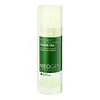What's inside
What's inside
 Key Ingredients
Key Ingredients

 Benefits
Benefits

 Concerns
Concerns

No concerns
 Ingredients Side-by-side
Ingredients Side-by-side

Water
Skin ConditioningDipropylene Glycol
HumectantGlycerin
HumectantButylene Glycol
HumectantPropanediol
SolventMethylpropanediol
SolventNiacinamide
SmoothingVincetoxicum Atratum Extract
Skin ConditioningPhellinus Linteus Extract
Skin ConditioningAlthaea Rosea Flower Extract
Skin ConditioningChitosan
Malus Domestica Fruit Cell Culture Extract
Skin ConditioningHydroxyacetophenone
AntioxidantBetaine
HumectantAllantoin
Skin ConditioningPanthenol
Skin ConditioningCaprylyl Glycol
EmollientPolyglyceryl-10 Isostearate
Skin ConditioningEthylhexylglycerin
Skin ConditioningAdenosine
Skin Conditioning1,2-Hexanediol
Skin ConditioningPolyglyceryl-10 Oleate
Skin ConditioningSodium Phytate
Glutathione
Beta-Glucan
Skin ConditioningPentylene Glycol
Skin ConditioningGlucosylrutin
AntioxidantHydrogenated Lecithin
EmulsifyingCholesterol
EmollientAscorbic Acid
Antioxidant3-O-Ethyl Ascorbic Acid
Skin ConditioningAscorbyl Glucoside
AntioxidantCeramide NP
Skin ConditioningCapryloyl Salicylic Acid
ExfoliatingFerulic Acid
AntimicrobialMadecassoside
AntioxidantTocopherol
AntioxidantLactic Acid
BufferingDipotassium Phosphate
BufferingAcetyl Glutamine
Skin ConditioningCellulose Gum
Emulsion StabilisingCaffeine
Skin ConditioningXanthan Gum
EmulsifyingWater, Dipropylene Glycol, Glycerin, Butylene Glycol, Propanediol, Methylpropanediol, Niacinamide, Vincetoxicum Atratum Extract, Phellinus Linteus Extract, Althaea Rosea Flower Extract, Chitosan, Malus Domestica Fruit Cell Culture Extract, Hydroxyacetophenone, Betaine, Allantoin, Panthenol, Caprylyl Glycol, Polyglyceryl-10 Isostearate, Ethylhexylglycerin, Adenosine, 1,2-Hexanediol, Polyglyceryl-10 Oleate, Sodium Phytate, Glutathione, Beta-Glucan, Pentylene Glycol, Glucosylrutin, Hydrogenated Lecithin, Cholesterol, Ascorbic Acid, 3-O-Ethyl Ascorbic Acid, Ascorbyl Glucoside, Ceramide NP, Capryloyl Salicylic Acid, Ferulic Acid, Madecassoside, Tocopherol, Lactic Acid, Dipotassium Phosphate, Acetyl Glutamine, Cellulose Gum, Caffeine, Xanthan Gum
Glycerin
HumectantWater
Skin ConditioningCocos Nucifera Oil
MaskingPalmitic Acid
EmollientLauryl Betaine
CleansingBetaine
HumectantCamellia Sinensis Leaf
PerfumingCamellia Sinensis Seed Oil
HumectantCamellia Japonica Seed Oil
EmollientOlea Europaea Fruit Oil
MaskingHelianthus Annuus Seed Oil
EmollientLimnanthes Alba Seed Oil
Skin ConditioningOenothera Biennis Oil
EmollientTocopheryl Acetate
AntioxidantCitrus Aurantifolia Oil
CleansingOcimum Basilicum Oil
MaskingCananga Odorata Flower Oil
MaskingCitrus Limon Peel Oil
MaskingOriganum Heracleoticum Flower Oil
MaskingCitrus Aurantium Dulcis Peel Oil
MaskingParfum
MaskingGlycerin, Water, Cocos Nucifera Oil, Palmitic Acid, Lauryl Betaine, Betaine, Camellia Sinensis Leaf, Camellia Sinensis Seed Oil, Camellia Japonica Seed Oil, Olea Europaea Fruit Oil, Helianthus Annuus Seed Oil, Limnanthes Alba Seed Oil, Oenothera Biennis Oil, Tocopheryl Acetate, Citrus Aurantifolia Oil, Ocimum Basilicum Oil, Cananga Odorata Flower Oil, Citrus Limon Peel Oil, Origanum Heracleoticum Flower Oil, Citrus Aurantium Dulcis Peel Oil, Parfum
 Reviews
Reviews

Ingredients Explained
These ingredients are found in both products.
Ingredients higher up in an ingredient list are typically present in a larger amount.
Betaine is a common humectant (a substance that promotes retention of moisture). It's known to be gentle on the skin and can help balance hydration.
This ingredient is best for improving hydration and soothing irritated skin. Studies also show it helps even out skin tone.
Fun fact: Betaine is naturally created in the skin and body. The kind found within cosmetic products can be either plant-derived or synthetic.
Another name for betaine is trimethylglycine.
Learn more about BetaineGlycerin is already naturally found in your skin. It helps moisturize and protect your skin.
A study from 2016 found glycerin to be more effective as a humectant than AHAs and hyaluronic acid.
As a humectant, it helps the skin stay hydrated by pulling moisture to your skin. The low molecular weight of glycerin allows it to pull moisture into the deeper layers of your skin.
Hydrated skin improves your skin barrier; Your skin barrier helps protect against irritants and bacteria.
Glycerin has also been found to have antimicrobial and antiviral properties. Due to these properties, glycerin is often used in wound and burn treatments.
In cosmetics, glycerin is usually derived from plants such as soybean or palm. However, it can also be sourced from animals, such as tallow or animal fat.
This ingredient is organic, colorless, odorless, and non-toxic.
Glycerin is the name for this ingredient in American English. British English uses Glycerol/Glycerine.
Learn more about GlycerinWater. It's the most common cosmetic ingredient of all. You'll usually see it at the top of ingredient lists, meaning that it makes up the largest part of the product.
So why is it so popular? Water most often acts as a solvent - this means that it helps dissolve other ingredients into the formulation.
You'll also recognize water as that liquid we all need to stay alive. If you see this, drink a glass of water. Stay hydrated!
Learn more about Water